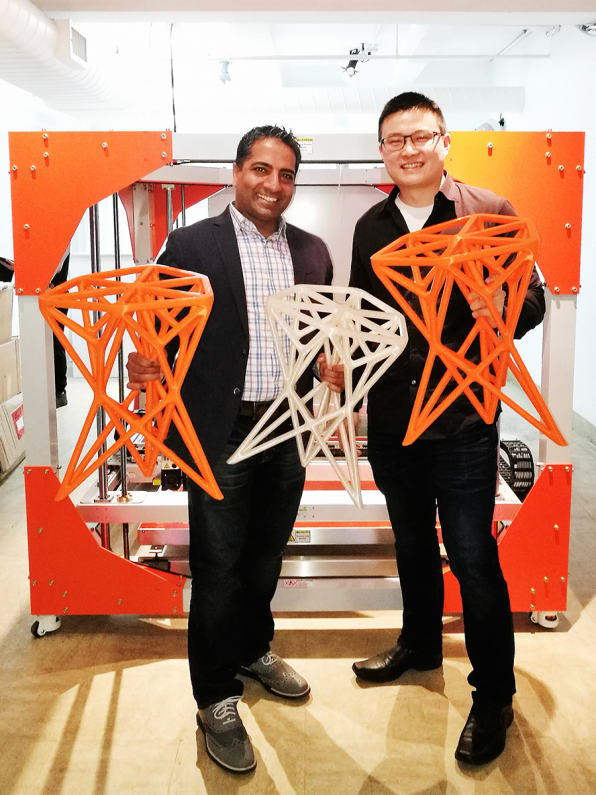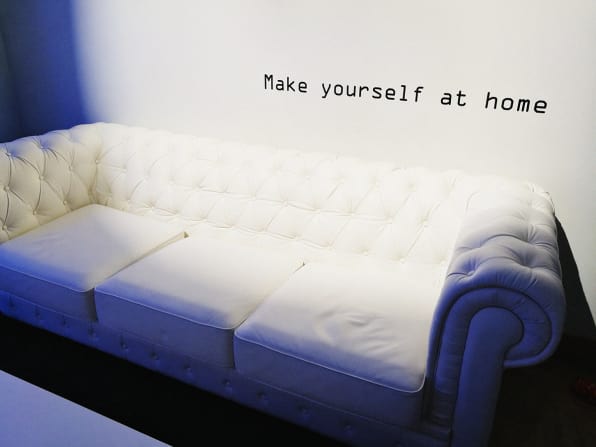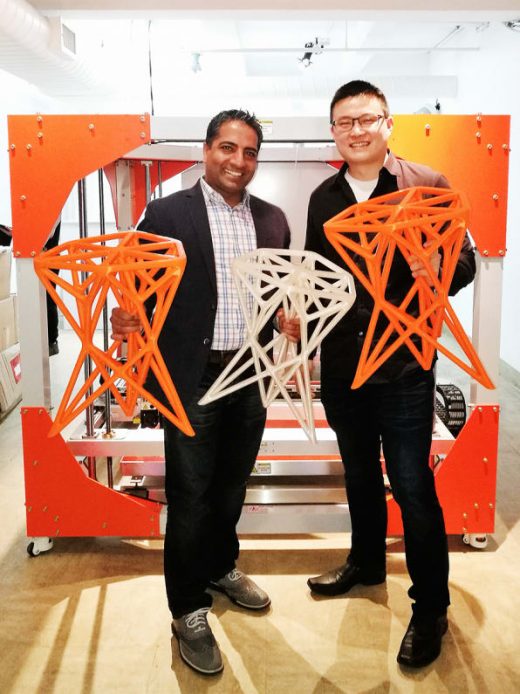You Can Now Get 3D-Printed Designer Furniture That Won’t Break The Bank
At first glance the Print the Future shop in midtown Manhattan looks much like any other sleek designer homeware store. Look closer, however, and you’ll notice that the geometric stools, chunky chairs, and curvaceous settee have something rather unusual in common. They’ve all been 3D printed by a machine like the one currently whirring away in the back of the room as it makes a bright blue stool to add to this stylish display.
The idea behind Print the Future is to enable a community of designers to convert their ideas into 3D objects that are both practical and beautiful, and to sell these directly to consumers. Their pop-up shop—which stays open in Manhattan until March 31st—is to show these consumers that the technology has moved beyond being a gimmick and is now a viable way to produce customized and useful products.

The Vancouver-based company currently has an online presence and large-scale printing operations set up with partners in Sweden and Germany, but the plan is to roll out this model they’re piloting in New York on a permanent basis, opening up shops in major cities where customers can come in to discuss and co-design their 3D-printing ideas, watch the items materialize, and collect them once they’re finished.
Their ambitious plan is to capture at least a 5% to 10% share of the 3D-printing market, which is predicted to double in size to reach $35 billion by 2020. In order to do that, they will start by disrupting the home furnishings market by offering customized furniture printed to order within 24 hours, with prices currently ranging between $500-$1,500. Print the Future CEO and Founder Neil Patel’s previous company, Kabuni, is a marketplace that connects interior designers with their customers, and they plan on using that existing community as a springboard to quickly scale up.
There’s been plenty of investment and hype around delivery technology in recent years—it’s a concept that is fundamentally even more disruptive than the idea of having a drone delivering your Amazon order. “I grew up watching Doctor Who, and what we’re talking about is that science fiction concept of zapping ideas across space,” says Patel. “The idea that you can upload a design and have it materialize as a complete product halfway across the world, is incredibly powerful.”
That’s why Patel says that having physical shops where people can see this happening and touch the products is such a game changer. When I visited the pop-up shop for the first time, they set the printer to make an intricate blue stool, and what started as a flat disc of plastic gradually started taking form as we talked and the layers built up. By the time I came back the next day, it had been completely finished, and I sat on that stool as we finished our interview. Seeing something born in front of your eyes like builds an emotional attachment to that object, and logic dictates that’s a good thing for the seller, since it makes you more likely to buy it.

The word “born” feels appropriate here in spite of the fact we’re referring to a process done by machine. There is something rather organic about it, where the layers are gradually built from materials forming a variety of geometric micro-patterns, interlinking and layering them according to each individual design. In fact, biomimicry is quite a hot trend in 3D printing at the moment.
Award-winning designer Lori Dennis—who is on Print the Future’s board and will have her own signature line of 3D-printed furniture on the platform—says that we’ve only just started scratching the surface as far as exploring the design possibilities enabled by the medium. In addition to the vast array of printable shapes, sizes, and textures, it will soon become a lot more practical to incorporate other materials such as glass, metal, wood, and even fabric into the process. This, she believes, will empower designers to become much more creative, and will make designer items much more accessible to everyone. “It’s probably safe to say that the majority of our early adopters will be millennials who value customization and speed,” she explains.
And while speed is certainly not something most of us associate with 3D printing, the process has become a lot more quick and efficient in recent years. To illustrate that, Lori describes how she was speaking at a conference in L.A. and wanted a customized tray to show her audience. Within less than 20 hours of sending a brand-new design to Print the Future COO Raj Bharti, they had the tray printed and delivered to her in time for her presentation.

In the future, however, it should be possible to skip this shipping stage altogether, as you’d be able to find the nearest printing facility from which to pick up your materialized idea. And that’s one of the aspects that makes this a surprisingly sustainable proposition: Not only are the materials 100% recyclable, but the printing only uses the exact quantities needed, generating no waste. The biggest potential impact, however, will come when the local printing model scales, and large items that currently have to be shipped over long distances throughout the manufacturing and distribution process can instead be produced and delivered locally. By shipping ideas instead of atoms, Patel hopes to create an ecosystem where 3D printing enables billions of dollars in savings in shipping costs, generating a much smaller carbon footprint in the process. Ultimately, his vision is to create a borderless economy that decentralizes e-commerce and brings it closer to the consumer.
Patel believes that eventually most people will own their own 3D printer, but he isn’t worried about this derailing his plans. “Everybody has a coffee machine at home, but Starbucks thrives. It’s a different product and experience. There’s room for both.”
Fast Company , Read Full Story
(55)














